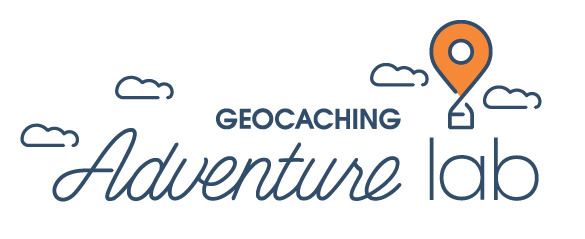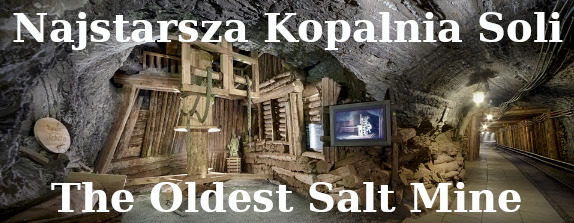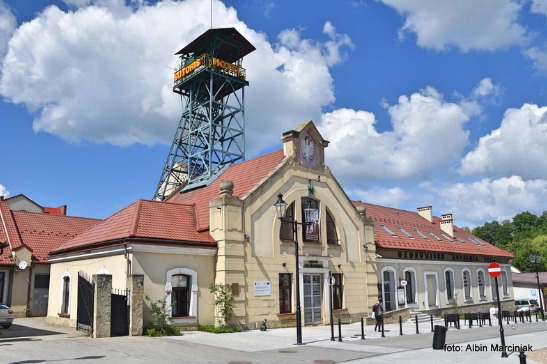
Uwaga!
By zdobyć tę skrzynkę musisz wcześniej ukończyć scenariusz Adventure Lab Cache dostępny w specjalnej aplikacji.
Współrzędne finału obliczysz za pomocą kodów bonusowych dostępnych w scenariuszu.
Attention!
To find this cache you have to finish Adventure Lab Cache scenario available in a special app. The coordinates of the cache can be calculated with the help of bonus codes available within scenario.
Kliknij by otworzyć scenariusz / Click to open the scenario:

Pobierz oficjalną aplikację / Get the official app:


 Najstarsza Kopalnia Soli w Polsce
Najstarsza Kopalnia Soli w Polsce 
Diabli nadali - tytuł tak długi, że nigdzie nie zmieścił się w całości i dosłownie w każdym miejscu tej lab-serii brzmi nieco inaczej. Mam jednak nadzieję, że dla tak dzielnego poszukiwacza jakim jesteś Ty nie będzie problemem ogarnięcie się w tym małym misz-maszu. Na wstępie słowo wyjaśnienia - wszystkie opisy w języku polskim znajdziesz w scenariuszu jednak każdy lab opatrzony jest również angielskim nagłówkiem dzięki któremu niepolskojęzyczni gracze również będą mieli okazję poznać historię bocheńskiej kopalni.
Labcache nie mają narzuconej kolejności lecz polecam podejmować je w następującej kolejności:
1. Szyb Sutoris
2. Wszystko co dobre...
3. Zamek i Planty Salinarne
4. Szyb Campi
5. Kolejka Linewkowa.
Etap 4. Jest otwarty codziennie w godzinach co najmniej 8-20 (maximum 6-22). Jeśli jednak udało ci się trafić na zamkniętą bramę możesz wykonać zadanie alternatywne - Odpowiedzią do laba będzie "0(3+X)10(4+Y)", gdzie XY to liczba betonowych schodków na prawo od bramy.
Jeśli poruszasz się samochodem to dobrym pomysłem może być zaparkowanie w centrum (pamiętaj, że parking przy plantach jest płatny!), wykonanie pierwszych 3 etapów, podjechanie pod szyb Campi, wykonanie 4. etapu, zjechanie w dół obwodnicy, zaparkowanie przy cmentarzu i podejście na piechotę po 5. etap. Na koniec pozostanie ci ta oto skrytka bonusowa po którą również możesz podjechać i zostawić auto po przeciwnej stronie ulicy. Wszystkie (za wyjątkiem tego przy bonusie) parkingi oznaczone są waypointami.
Wszystkie labcache oznaczone są waypointami w listingu tej skrytki a sam finał znajduje się nie więcej niż 10min spacerem od ostatniego etapu. Zakładając, że poruszać się będziesz piechotą całość nie powinna zająć ci więcej niż 60min. Skrytka bonusowa znajduje się na prywatnej posesji, gdzie została umieszczona za zgodą właściciela aczkolwiek jest dostępna z chodnika. Proszę w miarę możliwości nie deptać trawy i w szczególności nie opierać się o kesza. Poza standardowymi przedmiotami na wymianę w keszu na pierwszych 3 znalazców czekają certyfikaty - dla kolejnych tematyczne PWG, które zostały przewidziane jako nagroda za ukończenie serii (biorąc takiego drewniaczka nie musisz zostawiać nic w zamian).
Na koniec dołączam listę skrytek, które możesz chcieć podjąc podczas robienia tych labów a które to znajdują się na ich trasie albo bardzo blisko niej:
1. Stare szyby kopalniane w Bochni
2. Kopalnia Soli Bochnia / Bochnia Salt Mine (Earthcache wymagający zjazdu do kopalni)
3. MPEC Bochnia
4. Bocheńskie Dęby Pamięci (Multi z alternatywnym wzorem dla rozwiązujących laby - i tak odwiedzisz wszystkie etapy a nie ma sensu niepotrzebnie się wracać :) )
5. Kolumny lotników - Bochnia
6. Dworzec kolejowy w Bochni
7. Red - 2 czerwone kwadraty (Zagadka, D:3.5)
Skrytkę odnajdziesz na współrzędnych:
N 49° 5D.ABC E 20° 2E.ABC

 The Oldest Salt Mine in Poland
The Oldest Salt Mine in Poland 
As Adventure lab's description is very limited in length I've been forced to move English texts into this listing. All titles and questions within the app are available both in English and Polish but in order to read about the history of places described in them you'll have to use references from the lab's content. For the very same reason title of the series vary from place to place but I believe it won't cause you any problems.
You can solve these Adventure labs in any order you want yet I strongly recommend doing them in the following manner:
1. Sutoris shaft
2. All good things...
3. Salina garden and castle
4. Campi shaft
5. Cable railway
If you've come by car it may be a good idea to leave it in the town center (remember that parking by city park is paid!), collect the first 3 stages, drive to Campi shaft, collect stage nr 4, drive down the road, leave the car by the cemetery and walk to the last stage. After completing this Adventure you can drive to the bonus cache - feel free to park on the other side of the street from it. All parking spots (excluding one by bonus cache) are marked by waypoints provided in this listing.
All lab caches are marked by waypoints and the bonus cache itself is around 10min of walk from the last stage. If you decide to find all stages and the bonus on foot it shouldn't take you more than 60min. The bonus cache is located on the front yard of private property but it's available from the pavement. Please don't walk on the grass and by any means do not lean on the cache! Besides the standard box of items for trade, there are 3 certificates for first finders and a box of Polish Wooden Geocoins - these are not for trade - take one as a reward for finishing this series.
I've also prepared a list which you may find useful if you're interested in caching while visiting the next stages of this Adventure. These are the caches that you can find on your route or really close to it:
1. Stare szyby kopalniane w Bochni
2. Kopalnia Soli Bochnia / Bochnia Salt Mine (Earthcache requiring visiting the mine)
3. MPEC Bochnia
4. Bocheńskie Dęby Pamięci (Multi, only in Polish)
5. Kolumny lotników - Bochnia
6. Dworzec kolejowy w Bochni (Multi, only in Polish)
7. Red - 2 czerwone kwadraty (Mystery cache, D:3.5)
Adventure labs' descriptions:
Bochnia's Salt Mine remains the oldest mine of rock salt in Poland and the longest operating industrial company in the whole of Europe. Salt hasn't been discovered randomly overnight though. The first signs of people retrieving it from salty streams come from the end of Neolithic, 6000-6500 years ago. Soon after that people started digging wells which filled with brine. In the year 1135 Pope Innocent II wrote in his documents about the salt works plant operating near, in the year 1998 the Patriarch of Jerusalem documents a gift of the Polish salt from Bochnia, and in the year 1248 there is finally the rock salt found in here. For the people from the middle ages, salt had incredible value so things run fast from now - regular salt mining starts in 1251 and Bochnia gets its city rights in 1253 - 4 years sooner than Cracow itself! In the document confirming city rights town gets 2 names - Polish (Bochnia) and German - Saltzberg, which means The Salt Mountain.
1 - Sutoris shaft
Hungary - Anno Domini 1239 - 5-year old Kunegunda throws her ring into one of the brine wells and leaves the kingdom in which she was born, her destination - Poland. As the legend says just 9 years later Hungarian miners arrive in Poland with the young princess worked on dredging the brine well located near Babica stream, in the garden of the shoemaker who used to live in Bochnia. While digging they find a treasure way more valuable than they ever dreamed of - the rock salt. Kunegunda takes the first piece of white crystal which comes from the well and breaks it into pieces - to everybody's surprise a golden ring - once left in Transylvania - falls from the broken rock. 5 years later Kunegunda funds the St. Nicholas' church. Shoemaker's garden doesn't exist anymore, Babica flows just a few meters away from the place where it used to in St. Kunegunda's times and well... Old brine well evolved into the great shaft Sutoris - from Latin - Shoemaker's
The shaft's surroundings have been recently renovated. Thanks to this renovation you can sit in a very convenient place - just on the other side of the street. But hey... wait... Isn't this bench kinda... weird?
2 - All good things...
...come to an end. It's no different with the Regis shaft - one of the oldest and most efficient shafts of Old Mountains. From the time it was hollowed in the XIVth century till the day when it ran out of salt in the XVIIIth century the shaft was carved 180m down into the earth and had an impressive building on it's top. In the year 1923 building had been destroyed and the new post-modern tower was erected in its place. The tower itself lasted only till 1967. The shaft itself had been filled with rocks a long time ago but it has never been forgotten - just like the rest of the liquidated shafts it's commemorated with a black mining cart which during the warmer part of the year is used as a very unusual flower pot. A long time ago there was a white information board erected behind it but till today it has totally faded in the sun. Not so long ago there has been set a new route around the town's salt history and along with it new yellow information tables appeared near interesting places - one of them stands just next to this cart and tells its history in 4 languages. Do you remember how many carts like this have you seen today? Look around and try to spot as many as possible - share your score in the log to this Adventure lab.
But first - go around the cart...
3 - Salina garden and castle
Planty salinarne (salina garden, saltworks garden) in 1868 took place of the former castle's defensive circuit and salt market. The newly created object had a saltworks' pond and a beautiful bower similar to the one in Cracow. Bower used to host numerous concerts and dances so the park itself became a popular place for rest and entertainment for the citizens of Bochnia. The castle itself has a way richer history - first mentioned in 1368 but is definitely older - it was probably built just after Bochnia got city rights in 1253. The castle was the administrative center for the salt mine and became headquarters of the saltworks' administrators (a rather fancy polish word without English equivalent - Podżupek). The wooden building was rebuilt in stone during the reign of King Casimir the Great and in the XVIth century had its own arsenal and shooting tower. During the partitions of Poland building lost most of its functions and a bigger part of it as well as walls, towers and gates was demolished. Later on it was used for housing and today the only part left is the northern wing which is under the threat of collapsing at any time. Find a yellow plate with a castle on it.
4 - Campi shaft
Construction works for the Campi shaft begun in 1556. While digging, miners discovered vast beds of wet sand which is known for destroying all wooden structures of shafts. Because of these difficulties construction works were finished only after 12 years - investment appeared to be successful - the underground salt deposits which were discovered here were truly enormous. The Latin name Campi ("Field") meant that the shaft itself stood away from town - along with the Finder and Bochneris shafts they made a complex of New Mountains. In 1614 Finder shaft finished exploitation and was filled with rocks, in 1711 a tragic catastrophe happened in Bochneris shaft making it no longer available for exploitation. From this day on Campi remained the only working shaft on the west of Bochnia. Salt excavation lasted till 1990 and so after 742 years, the industrial-scale exploitation came to an end. Today there are still miners working in the mine but they retrieve only small amounts of salt used to make souvenirs and cosmetics.
The gate is open at least from 8 AM till 8 PM (it may be opened earlier and closed later). If the gates are closed you can solve an alternative task: answer for this lab will be "0(3+X)10(4+Y)" where XY stands for the number of concrete steps on the stairs located to the right of the gate.
5 - Cable railway
The cable railway was built by the Austro-Hungarian Empire during partitions of Poland - in the year 1900 to be exact - and was one of the first railways meant to transport goods within the borders of modern Poland. Progress of technology required modernization of salt transport - steam-powered machines were already used to crush and pack excavated salt blocks so it was only natural to modernize its transport too. The beginning station used to be located just next to the Campi shaft from where the 1020m long railway led to the final station located next to the train station. In the third decade of the XXth century it was replaced by rails. One thing worth noticing is that Austrians planned it with thorough precision resulting in assigning the very exact amount of 100 675 crowns and __ hallers to cover the costs.
The missing value can be found on the board which stands at the coordinates of this stage. Sadly the board says it in Polish only - find the number 100 675 and the next number after it will be the missing value.
The bonus cache can be found at the following coordinates:
N 49° 5D.ABC E 20° 2E.ABC
(Translated by myself, text correction - vw_k)